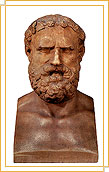Games and poetry
The games were constantly mentioned in ancient Greek poetry, already from the beginning of its history with Homer, who in crucial points of the plot of both his epics he chooses to describe athletic events quite vividly.  The Homeric standard will be followed much later by the Roman poet Virgil in his Aeneid. The Homeric standard will be followed much later by the Roman poet Virgil in his Aeneid.
The victory ode marks essentially the birth in the 6th century BC of a special literary genre, dedicated exclusively in the praise of athletic victories. The main representatives were Simonides of Kea, Pindar of Thebes and Bacchylides, the nephew of Simonides. The most prominent among them is undoubtedly Pindar (ca 518-446 BC). Forty-four of his victory hymns have been preserved and are dedicated to victors at Olympia, Nemea and Isthmia.
These were chorus songs that were sung at the victor's homeland during the celebration of his success or even in the area where the games took place. The main commissioner of Pindar was the Greek aristocracy of the first half of the 5th century AD, which considered the poet to be an excellent praiser of the old aristocratic values that were particularly threatened in a period of important political changes. Thus, the athletic success constituted an occasion for praising the victor and his virtue, his family and his wealth. As a matter of fact, this praise of aristocratic values is intertwined with the myth in a way that it complicates significantly the understanding of the content and presupposes a well-informed audience. Pindar's customers were mainly the tyrants of Sicily and the conservative aristocratic class of Aigina, who engaged in chariot races, wrestling, pankration and boxing (these two from a particular young age).
Another literary genre that was closely related to the praise of athletic victories and with the statues of victors is the epigram. It refers to small texts in rhyme, which as a rule were carved on the bases of the statues or on athletic objects (for example discus, halteres), dedicated to the gods. Although the creators of these were rarely mentioned, many such epigrams were attributed to Simonides. They should include the name of the winner and his father's name, the place of origin, the games in which victory was achieved, the event and age category. In later years they could be longer literary works, such as the parodies of the Greek satirical poet Lucillius, who lived and created in Rome during Nero's era and dealt particularly with wrestlers.
|
